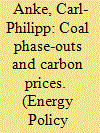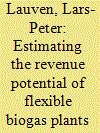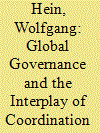|
|
|
Sort Order |
|
|
|
Items / Page
|
|
|
|
|
|
|
| Srl | Item |
| 1 |
ID:
187158


|
|
|
|
|
| Summary/Abstract |
China began to accelerate the energy transition in the last decade as a strategy for rebalancing its economy and becoming a more influential actor in the global renewable energy market. This article explores to what extent Chinese investment and financing in renewable energy projects in Argentina and Brazil promote these countries' energy transition strategies and sustainable development more broadly. To approach this question, the article provides a reading of Ostrom’s postulates of the energy transition as an increasingly relevant driver of certain states’ relationships with other countries. General trajectories of Chinese investment and lending in Latin America provide a background to Chinese investment in solar and wind power projects in Argentina and Brazil. The article concludes that China’s overseas finance merges with Argentina and Brazil’s own goals regarding renewable energy deployment and discusses future challenges in the context of the COVID-19 pandemic and its aftermath.
|
|
|
|
|
|
|
|
|
|
|
|
|
|
|
|
| 2 |
ID:
176896


|
|
|
|
|
| Summary/Abstract |
The European Union Emission Trading System (EU ETS) constitutes the core instrument of the European Union climate protection policy. It limits greenhouse gas emissions of its member states and aims at facilitating an efficient allocation of emission reduction across national borders. Accompanying this policy at the European level, individual member states have introduced national mitigation policies, including renewable energy (RES) expansion measures or coal phase-outs.
|
|
|
|
|
|
|
|
|
|
|
|
|
|
|
|
| 3 |
ID:
109695


|
|
|
|
|
| Publication |
2011.
|
| Summary/Abstract |
The quest for renewable energy sources has been strong in Spain for a couple of decades, and has produced outstanding results, notably in windpower. Solar technologies also had a prompt response to the promoting legislation of 2007. This evolution has generated side effects in the electricity generation system as a whole, and all this phenomenology is analysed in this paper under the consideration of the three objectives theoretically guiding electricity policy nowadays: security of supply (at macro and micro level), environmental quality, and economic competitiveness. The analysis points out some unbalance among the objectives, which can evolve to a scenario where back-up power is going to be a critical point for the stability of the system. Such a back-up service will surely be provided by gas-fired combined cycles (GFCC). The estimated projections of the generation system show that the required back-up power will grow about 8-9 GW by year 2020, for complying with the objective of attaining a share of 40% renewable electricity. However, collateral effects as the decline in the load factor of GFCC, as well as a reduction in spot price of electricity, can cast many doubts about the feasibility to reach that back-up power level.
|
|
|
|
|
|
|
|
|
|
|
|
|
|
|
|
| 4 |
ID:
150827


|
|
|
|
|
| Summary/Abstract |
Renewable energies are eco-friendly and sustainable. However, their development faces two critical issues: the uncontrollable generation variability, and the high levelized cost. These two issues impede the development of renewables substitution for a government from lacking of clearly argument of how to promote renewables substitution, and what is the role of traditional generation resources should play to back up the renewable energies in a target year. This study aims to depict the possibility of the concerned topic from the aspects of economy, security, and environment, taking a top–down viewpoint of policy-making to address an energy supply problem, and proposes an Energy Supply-Mix Model by considering the complimentary and substitution possibilities between renewable and non-renewable energies, and also among the renewable energies. The solution provides an overall assessment of three aspects under the conditions of supply and demand balance, desired generation percentage of renewable energies, and also ensure no shortage in peak-hour demand. Parametric analysis on the carbon tax is particularly conducted for policy making reference.
|
|
|
|
|
|
|
|
|
|
|
|
|
|
|
|
| 5 |
ID:
090088


|
|
|
|
|
| Publication |
2009.
|
| Summary/Abstract |
Since 1990, effective support schemes for renewable energies have been introduced mainly in European countries. In this article, the authors explain which consequences different general conditions could have on the design and functioning of feed-in laws. Cornerstones for an adjusted feed-in law to the particular general conditions of emerging and developing countries in South America will be drawn, which should give support to the decision-makers for designing an attuned and well-functioning feed-in legislation.
|
|
|
|
|
|
|
|
|
|
|
|
|
|
|
|
| 6 |
ID:
180109


|
|
|
|
|
| Summary/Abstract |
Although the European Union sets common objectives, each member country is in charge of its own energy policy. An exhaustive analysis of the power generation mixes of the EU member countries from 1990 to 2017 has revealed strong disparities in the evolution of their structure. Using key performance indicators, the paper analyzes the current situation in terms of carbon intensity, dependence, vulnerability and energy transition dynamics. The paper focuses on the transition dynamics for 12 emblematic EU countries. It is worthwhile to note that most of these countries have managed to reduce the carbon intensity of their electricity. The analysis revealed, for some countries, an empirical relationship between imports and the carbon intensity of power generation. The increase of the share of renewable energies induces a dependence of a country on its neighbors as long as a massive storage of electricity is not available. The increased electricity trade with neighboring countries induce costs and benefits. Only countries that have invested heavily in hydro and nuclear power benefit from both a low-carbon electrical production mix and a low dependence on imports. Finally, the paper suggests some avenues for public policies in the energy field.
|
|
|
|
|
|
|
|
|
|
|
|
|
|
|
|
| 7 |
ID:
092857


|
|
|
|
|
| Publication |
2009.
|
| Summary/Abstract |
The Energy [R]evolution 2008 scenario is an update of the Energy [R]evolution scenario published in 2007. It takes up recent trends in global socio-economic developments, and analyses to which extent they affect chances for achieving global climate protection targets. The main target is to reduce global CO2 emissions to 10 Gt per year in 2050, thus limiting global average temperature increase to 2 °C and preventing dangerous anthropogenic interference with the climate system. A review of sector and region specific energy efficiency measures resulted in the specification of a global energy demand scenario incorporating strong energy efficiency measures. The corresponding energy supply scenario has been developed in an iterative process in close cooperation with stakeholders and regional counterparts from academia, NGOs and the renewable energy industry. The Energy [R]evolution scenario shows that renewable energy can provide more than half of the world's energy needs by 2050. Developing countries can virtually stabilise their CO2 emissions, whilst at the same time increasing energy consumption through economic growth. OECD countries will be able to reduce their emissions by up to 80%.
|
|
|
|
|
|
|
|
|
|
|
|
|
|
|
|
| 8 |
ID:
166353


|
|
|
|
|
| Summary/Abstract |
The expansion of intermittent renewable power poses new challenges: Balancing fluctuations in power supply and demand requires additional flexibility. In this work, we model a unit commitment optimization problem to investigate the economic feasibility of concepts for flexible power generation from biogas. Because the economics of flexible power generation also depend on the availability of other flexibility options, we compared flexible biogas plants in power markets with different characteristics, namely Germany, northern Italy, and the islands of Sardinia and Sicily.
|
|
|
|
|
|
|
|
|
|
|
|
|
|
|
|
| 9 |
ID:
150896


|
|
|
|
|
| Summary/Abstract |
Liberalisation and the ever larger share of variable renewable energies (VRES), e.g. photovoltaic (PV) and wind energy, affect security of supply (SoS). We develop a system dynamics model to analyse the impact of VRES on the investment decision process and to understand how SoS is affected. We focus on the Swiss electricity market, which is currently undergoing a liberalisation process, and simultaneously faces the encouragement of VRES and a nuclear phase out. Our results show that nuclear production is replaced mainly by PV and imports; the country becomes a net importer. This evolution points to a problem of capacity adequacy. The resulting price rise, together with the subsidies needed to support VRES, lead to a rise in tariffs. In the presence of a high share of hydro, the de-rated margin may give a misleading picture of the capacity adequacy. We thus propose a new metric, the annual energy margin, which considers the energy available from all sources, while acknowledging that hydro-storage can function as a battery. This measure shows a much less reassuring picture of the country’s capacity adequacy.
|
|
|
|
|
|
|
|
|
|
|
|
|
|
|
|
| 10 |
ID:
186473


|
|
|
|
|
| Summary/Abstract |
The development of Renewable Energies (RE) must be stepped up in the coming years if we are to successfully realise the ambitious energy transition challenge set by many governments across the globe. However, the energy transition is far from obvious, especially with regard to the social acceptability of RE. In this context, we used a Discrete Choice Experiment combined with a Geographical Information System to assess the willingness of individuals to switch to a more virtuous energy mix based on three energy sources (wind, photovoltaic and biogas). Our results show a dominant generational effect, indicating that young people are more likely to accept renewable energy in their neighborhoods. Furthermore, residents in areas with renewable energy with negative externalities (wind turbines and anaerobic digestion units) tend to have a lower Willingness to Pay than residents in other areas, which is what we call the principle of territorial distributive justice. There is no reason to believe that the difficulties in finding new locations for RE installations could fade away. Therefore, an increased effort of public policies to plan the location of future RE facilities in a more equitable way and always a better explanation and co-construction of new RE projects are needed.
|
|
|
|
|
|
|
|
|
|
|
|
|
|
|
|
| 11 |
ID:
149833


|
|
|
|
|
| Summary/Abstract |
Globally, small islands below 100,000 inhabitants represent a large number of diesel based mini-grids. With volatile fossil fuel costs which are most likely to increase in the long-run and competitive renewable energy technologies the introduction of such sustainable power generation system seems a viable and environmental friendly option. Nevertheless the implementation of renewable energies on small islands is quite low based on high transaction costs and missing knowledge according to the market potential.
|
|
|
|
|
|
|
|
|
|
|
|
|
|
|
|
| 12 |
ID:
162021


|
|
|
|
|
| Summary/Abstract |
Developing an adequate sustainable energy supply in developing countries is a major challenge for the global community. Recently, a large number of organizations and enterprises have been supporting technological development, carrying out advocative actions, and offering finance for renewable energy. Concomitantly, there have been strong calls to improve coordination in this field. This article elaborates on the importance of institutional opportunities not only to favor coordination, but also to contest common wisdom shaping energy policies and specific project features at a given time. The result would be a more flexible renewable energy “governance dynamics” to provide the institutional framework for private actors and the interaction with public entities. Thus, three dimensions of global governance are analyzed: coordination, contestation, and the resulting process of collective/interactive regulation.
|
|
|
|
|
|
|
|
|
|
|
|
|
|
|
|
| 13 |
ID:
112247


|
|
|
|
|
| Publication |
2012.
|
| Summary/Abstract |
Almost all countries have issued laws and regulations to promote renewable energy (RE). However, the applications and motivations of such laws as well as achievements have been different. Currently, the Japanese government has announced its targets to expand the electricity feed-in tariff scheme for solar power, along with other energy sources, within two years to meet the goal set by the Japanese Prime Minister who, in the 15th United Nations Climate Change Conference (COP15) held in September 2009, proclaimed to cut 25% of greenhouse gas (GHG) emissions from the 1990 levels by 2020. In this paper, the current Japanese energy policies and measures for promoting RE in comparison to popular methods followed worldwide are explored. Furthermore, a Least Cost Feed-in Tariff (LCFIT) Simulation Model for Japanese case was developed to calculate the optimal mix of technologies to reach certain targets. The LCFIT also calculates the tariff that should be proposed for each technology and the total cost for the program with and without a carbon tax and estimates the premium added to the bill of the customer every month.
|
|
|
|
|
|
|
|
|
|
|
|
|
|
|
|
| 14 |
ID:
105792


|
|
|
|
|
| Publication |
2011.
|
| Summary/Abstract |
For the large-scale integration of electricity from renewable energy sources (RES-E), the German system seems to reach its limits. In 2009, the electricity wholesale market experienced serious negative prices at times of high wind and low demand. The feed-in system in Germany consists of a fixed feed-in price, a take-off obligation and a RES priority rule, and in practice only very restrictive use of RES-E curtailment. Exactly the latter is the problem. We argue that the overall performance of the system would improve seriously by lifting the restrictions on the use of voluntary curtailment agreements, while retaining the priority rule as such. Since generators of RES-E can only improve under this system reform, investment conditions improve, leading to higher installed RES-E capacity. This in turn implies that reduced wind output due to curtailment can actually be offset by higher wind output in all periods in which there is no problem.
|
|
|
|
|
|
|
|
|
|
|
|
|
|
|
|
| 15 |
ID:
096630


|
|
|
|
|
| Publication |
2010.
|
| Summary/Abstract |
While uptake of renewable energies as a solution to climate change is widely discussed, the issue of public vs. private financing is not yet adequately explored. The debates over the Kyoto Protocol and its successor, culminating in the COP15 Climate Change Conference in Copenhagen in December 2009, maintained a strong preference for public over private financing. Yet it is also clear to most observers that the energy revolution will never happen without the involvement of private finance to drive private investment. In this Viewpoint, we discuss the ways in which private financing could be mobilized to drive the energy industrial revolution that is needed if climate change mitigation is to succeed.
|
|
|
|
|
|
|
|
|
|
|
|
|
|
|
|
| 16 |
ID:
097468


|
|
|
|
|
| Publication |
2010.
|
| Summary/Abstract |
While uptake of renewable energies as a solution to climate change is widely discussed, the issue of public vs. private financing is not yet adequately explored. The debates over the Kyoto Protocol and its successor, culminating in the COP15 Climate Change Conference in Copenhagen in December 2009, maintained a strong preference for public over private financing. Yet it is also clear to most observers that the energy revolution will never happen without the involvement of private finance to drive private investment. In this Viewpoint, we discuss the ways in which private financing could be mobilized to drive the energy industrial revolution that is needed if climate change mitigation is to succeed.
|
|
|
|
|
|
|
|
|
|
|
|
|
|
|
|
| 17 |
ID:
191235


|
|
|
|
|
| Summary/Abstract |
A long-lasting, large-scale power blackout has a huge impact on the infrastructure of public life, as well as on critical infrastructure including electricity and water supply. At the same time, it can be observed that the share of renewable energies, and thus the possibility of self-sufficiency, has increased enormously in recent years. This contribution focuses on the question to what extend citizens are willing to share their electricity resources in order to make their city more resilient. In reference to Ostrom's concept of club or common goods, it can be shown if and how the private good of citizen's electricity resources can be transformed into a club or even a common good. Drawing on survey data from the city of Darmstadt we investigated the willingness to share electricity and to participate in participatory formats to enhance urban resilience.
|
|
|
|
|
|
|
|
|
|
|
|
|
|
|
|
| 18 |
ID:
126823


|
|
|
|
|
| Publication |
2014.
|
| Summary/Abstract |
In this paper, we analyze the rationale for an energy policy mix when the European Emissions Trading Scheme (ETS) is considered from a public choice perspective. That is, we argue that the economic textbook model of the ETS implausibly assumes (1) efficient policy design and (2) climate protection as the single objective of policy intervention. Contrary to these assumptions, we propose that the ETS originates from a political bargaining game within a context of multiple policy objectives. In particular, the emissions cap is negotiated between regulators and emitters with the emitters' abatement costs as crucial bargaining variable. This public choice view yields striking implications for an optimal policy mix comprising RES supporting policies. Whereas the textbook model implies that the ETS alone provides sufficient climate protection, our analysis suggests that support for renewable energies (1) contributes to a more effective ETS-design and (2) may even increase the overall efficiency of climate and energy policy if other externalities and policy objectives besides climate protection are considered. Thus, our analysis also shows that a public choice view not necessarily entails negative evaluations concerning efficiency and effectiveness of a policy mix.
|
|
|
|
|
|
|
|
|
|
|
|
|
|
|
|
| 19 |
ID:
109707


|
|
|
|
|
| Publication |
2011.
|
| Summary/Abstract |
The future economic development trajectory for India is likely to result in rapid and accelerated growth in energy demand, with expected shortages. Many of its current policies and strategies are aimed at the improvement and possible maximization of energy production from the renewable sector. It is also clear that while energy-conservation and energy-efficiency can make an important contribution in the national energy strategy, renewable energies will be essential to the solution and are likely to play an increasingly important role for the growth of grid power, providing energy access, reducing consumption of fossil fuels, and helping India pursue its low carbon progressive pathway. However, most of the states in India, like the northernmost State of Jammu and Kashmir (J&K), have experienced an energy crisis over a sustained period of time. As India intends to be one of the emerging powers of the 21st century, it has to embark upon with these pressing issues in a more sustainable manner and accordingly initiate various renewable energy projects within these states. This paper will provide a broad-spectrum view about the energy situation within J&K and will highlight the current policies along with future strategies for the optimal utilization of renewable energy resources.
|
|
|
|
|
|
|
|
|
|
|
|
|
|
|
|
| 20 |
ID:
112914


|
|
|
|
|
| Publication |
2012.
|
| Summary/Abstract |
In this paper we identify the renewable energy source (RES) demand scenarios for Morocco, the needs of RES installed capacity according to those scenarios and the detailed investment plans needed to achieve such installed capacity supply. Then, using a dynamic variant input-output model, we simulate the macroeconomic impact of the foreign investment inflows needed to make available these Moroccan RES generation capacity plans in the medium and long term. The use of concentrated solar plants, photovoltaic generation and wind power farms are considered and compared in the simulation.
|
|
|
|
|
|
|
|
|
|
|
|
|
|
|
|
|
|
|
|
|